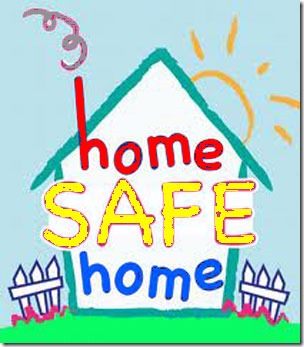Your home is the safest place you could possibly be, right? Although we may feel protected encompassed in the metaphorical hug of the family home, we are in fact amidst a time-bomb of potential disasters if safety at home measures are not put into place. This is particularly important should you have mini or junior household members.
We all know how much our toddlers love the outdoors and to mimic us adults and help out with household chores. Add this concoction of innocence and enthusiasm with access to your garden shed and the results could be fatal.
The garden shed provides an amazing place of exploration for small children. It is easily transformed into a time-machine, a fort or a royal palace with a little imagination, but the hazards that hide amongst the tools and brick-a-brack are extremely real.
Aside from the array of garden and household tools that can quickly manifest themselves into weapons in the wrong hands, sheds are usually full of harmful chemicals. Stored tins of paints, stains and varnishes, bottles of white spirit, cans of antifreeze and de-icer are just a few of the killer items that make their way to the depths of the garden shed through the year.
The garden shed is traditionally the place to store all we need to keep the outside of our house pest free and well manicured too. These items can include weed killer, rat poison, slug pellets and fly killer, the titles of these products ring alarm bells instantly.
With suspected poisoning being one of the most common reasons young children are taken to Accident and Emergency departments it is imperative that you are aware of the dangers in the home, the signs and symptoms of poisoning as well as what safety measure to put in place.
Safety Tips
Ensure that children are supervised when playing outside. They are very inquisitive and just can’t help but explore, and they love to try and be helpful with tasks they have seen adults do previously.
Keep all dangerous chemicals, pesticides and insecticides stored out of reach of children, or ideally under lock and key.
Never transfer harmful chemicals into alternative containers, such as recycled food jars or drinks bottles. This will avoid causing confusion to both children and other family members who may think these items are consumable.
Be aware that not all lids or tops are child proof and even items labelled “child proof” can be hacked into by the most resourceful and determined of children.
Signs and Symptoms of Poisoning
Poisoning from chemicals or toxins can be caused by swallowing, inhalation or from the chemical or toxin being splashed onto the skin. The signs and symptoms of such an incident will depend on the amount or type or toxin the subject has been exposed to.
The signs that may indicate poisoning are:
- Open or out of place chemical containers.
- Spills or stains on the floor, skin or clothing.
- Unusual smells in the air, on the clothing or breath of the subject.
The symptoms can range from mild to moderate through to severe. Mild symptoms can include:
- Nausea or vomiting
- Diarrhoea
- Dizziness
- Drowsiness
- Tiredness
- Headache
- Skin and/or eye irritation
What action should be taken?
Young children can not tell you the facts of an incident effectively. So, if you suspect that your child has accidentally come into contact with a pesticide head straight to the Accident & Emergency department armed with the offending product container.
Do not give your child water to drink, this will only push the poison round the body and you may not know how much has been swallowed.
Do not give your child anything to make them sick either, leave it to the professionals.
Do you have any tips or tricks to share about keeping hazardous substances staff from little rascals? Let us know by leaving a comment.
